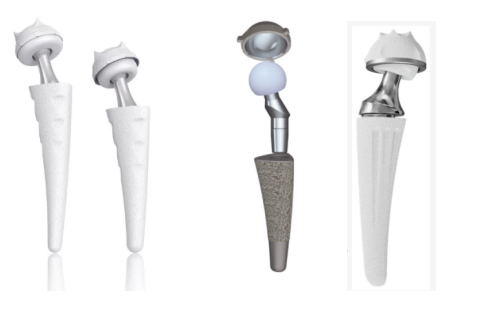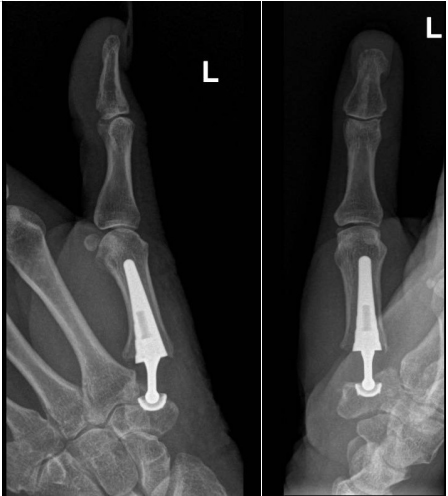|
Thumb CMC-joint replacement surgery
Introduction
Many people develop arthritis in the joint at the base of the thumb between the base of the metacarpal and the trapezium bone. This joint is also known as the CMC-joint (carpo-metacarpal joint). There are different ways of dealing with the symptoms from CMC-joint arthritis ranging from non-operative treatment so surgery. Joint replacement surgery for arthritis at the base of the thumb has gained in popularity in recent years thanks to a new generation of dual mobility implants. Suitable patients can benefit from quicker recovery and better functional outcomes compared to traditional surgical techniques like trapeziectomy (excision of the trapezium bone).
What is arthritis at the base of the thumb?
Arthritis is wear and tear affecting joints. The smooth gliding surfaces of joints become thinner and thinner until eventually bone is rubbing on bone. Joints with arthritis often deform and become broader and more swollen.
What are the symptoms of arthritis of the base of thumb CMC-joint?
Patients complain of pain in the area of the base of the thumb. The pain can cause problems with reduced grip and pinch strength. The arthritis also deforms the joint and the thumb, resulting in migration of the thumb into the palm. Patients often try to compensate for this “thumb-in-palm” deformity by hyperextending the neighbouring MCP-joint; this can result in what is called a Z-deformity.
Non-operative treatment
This includes simple things like pain killers and activity modification. Our specially trained Hand Therapists can take patients through a rehab and exercise programme that can help to reduce pain levels, whilst improving strength and function. Many patients benefit from using a thumb support splint. These splints come in different shapes and sizes. Some patients prefer the more rigid splints with a metal bar while others prefer the softer neoprene wraps. A so-called Push Brace can also be discussed with the Hand Therapist.
Injection options
Traditional steroid/cortisone injections into the affected joint are frequently used. They typically result in good pain relief within a few days. Unfortunately, cortico-steroid don’t cure arthritis and on average the effect only lasts for 3-4 months. Sometimes patients with early/mild arthritis experience longer-lasting pain relief from an injection. Other injection options include Platelet Rich Plasma (PRP) or viscosupplementation with Hyaluronic Acid.
More information on PRP and Hyaluronic Acid can be found here.
Surgical Treatment for thumb CMC-joint arthritis
For patients with severe pain and functional restrictions despite maximising non-operative treatment surgery can be a viable option. For many years the gold-standard procedure of choice has been the excision of the trapezium bone at the base of the thumb. This procedure is known as a trapeziectomy. Patients usually recover well, experiencing good pain relief while regaining satisfactory function. But it often takes a few months to recover and trapeziectomy surgery doesn’t correct the thumb-in-palm and Z-deformity. In recent years the introduction of a new generation of dual mobility joint replacement implants has proven to be an excellent treatment alternative. These implants look like a mini upside-down hip replacement. The outcomes of joint replacement surgery are usually superior to the outcomes of trapeziectomy surgery. Implants commonly used are MAIA, ELiS and Touch (see pictures below).

What are the advantages of base of thumb CMC-joint replacement surgery?
Patients undergoing base of thumb CMC-replacement surgery typically recover quicker than those undergoing trapeziectomy surgery. The replacement also allows better grip and pinch strength while experiencing less pain. Replacement surgery also allows for the correction of the thumb-in-palm and Z-deformities much better than excision of the trapezium bone. Many patients therefore prefer the more natural cosmetical appearance of their thumb following replacement surgery.
What are the disadvantages?
All joint replacements eventually fail from wear and tear. Scientific studies suggest that after 10 years we can expect more than 80% of CMC-joint replacements to still function well. Early failures are rare, but can include dislocation, loosening or fracture. Dependent on the precise mode of failure, the replacement can either be revised to a new implant or be converted to a traditional trapeziectomy.
How does CMC-joint replacement surgery work?
The procedure is usually carried out under general anaesthetic. An incision is made in the skin to allow for access to the joint. A small amount of bone is removed from the base of the metacarpal and the trapezium. A cementless stem is then implanted into the metacarpal bone. Special instruments are then used to create a bony bed for a cementless cup in the trapezium. Soft tissue tension is then gauged and a neck of appropriate length with a dual mobility head made of metal and polyethylene is then implanted. The procedure typically takes about 60-90 minutes.
Risks and complications
Risks and complications are rare. This includes pain, swelling, scar tenderness and accidental damage to nerves/vessels or tendons. If during surgery a fracture occurs, the implants may have to be removed, and the procedure is then converted to traditional trapeziectomy surgery. Joints can dislocate, break or loosen, requiring either revision to a new implant or conversion to trapeziectomy. There is a low risk of complications like infection or complex regional pain syndrome (CRPS). While most patients are happy with the outcome of surgery, there is a small risk of a poor or disappointing outcome.
What happens following surgery?
Patients should be able to go home on the day of surgery. The thumb is immobilised in a padded plaster-bandage. The other fingers are left free to allow patients some use of their hand straight away. 2 weeks following surgery patients start with rehab. Our hand therapists will remove all bandages and introduce a range of exercises to restore the function. This results in a gradual increase in strength and function. Patients initially use a support splint in the first few weeks. There will be restrictions on pinch/grip/manual work in the first few weeks, but there is a steady buildup in daily activities.

Xrays of a patient with CMC-joint replacement
| 